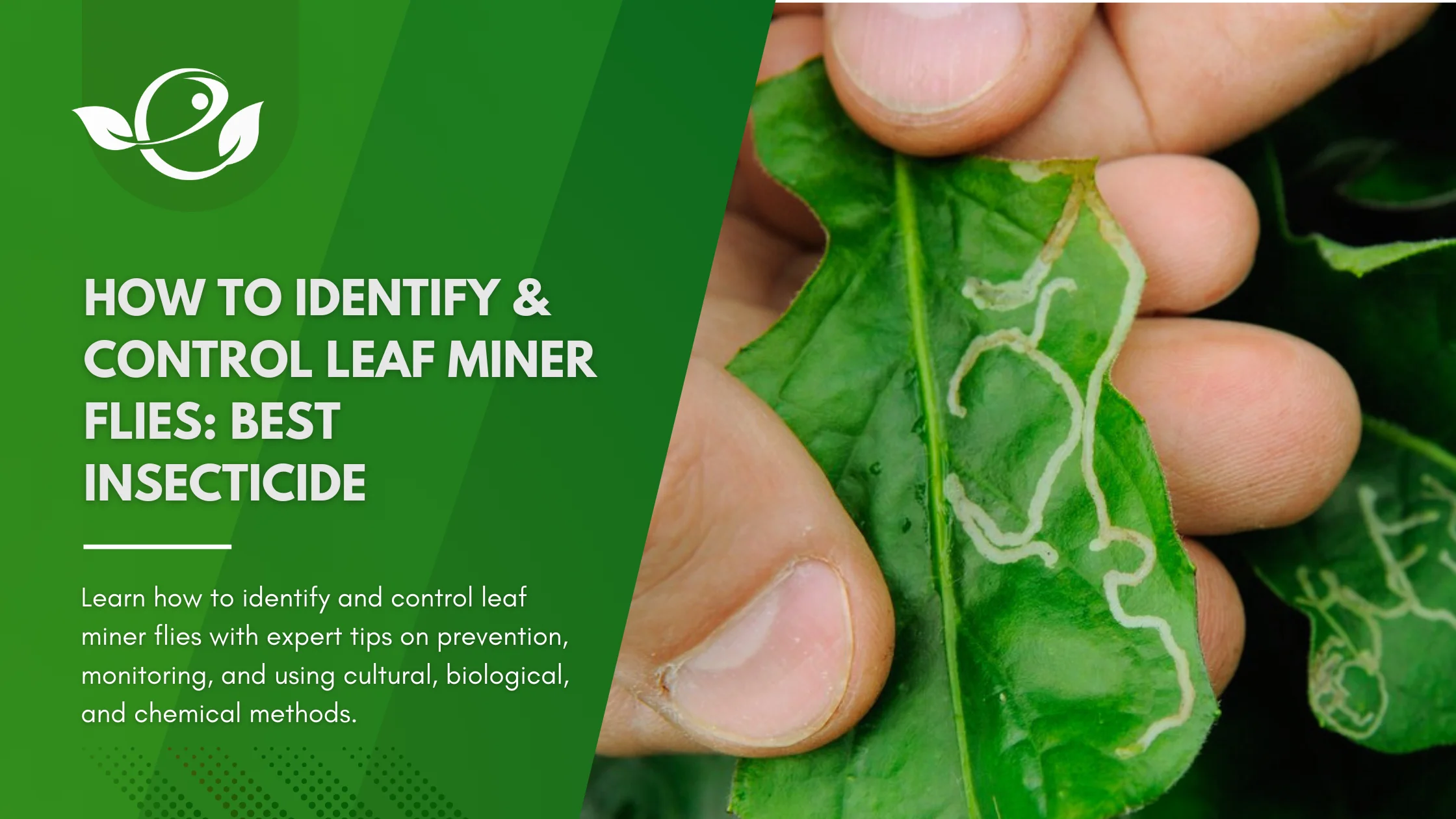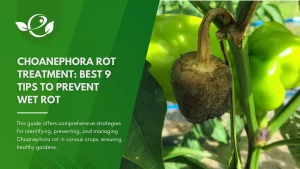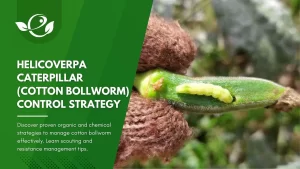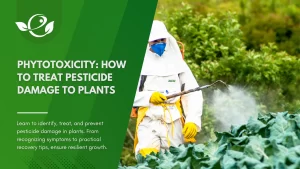Table of Contents
Imagine this: You’ve nurtured your garden with love, patiently waiting for that first glorious harvest. The tomatoes are ripening, the spinach is lush, and the citrus trees are brimming with potential. Then, out of nowhere, your plants start developing strange patterns on their leaves—like tiny maps drawn by a lost cartographer. At first, you might admire the artwork, but then you realize your garden is under attack. The culprits? Leaf miner flies, those tiny pests with a flair for leaving behind serpentine trails that scream trouble.
These little nuisances are the ultimate stealth artists, scribbling their destructive trails under the skin of your precious plants. And just like those mysterious doodles on a classroom desk, they’re hard to ignore once you see them. But unlike innocent doodles, these trails are a sign that your plants are in danger. And if you don’t act fast, you might be left with nothing but a sad, wilted garden.
In this guide, we’re going to unravel the mystery of leaf miner flies—identifying them, understanding their sneaky ways, and most importantly, showing you how to kick them out of your garden for good. So, buckle up, because it’s time to outsmart these tiny terrors before they turn your garden into their personal art studio!
Understanding Leaf Miner Flies
What Are Leaf Miner Flies?
Leaf miner flies might sound like something out of a sci-fi movie, but they’re very much real—and they’re not here to help your garden. These tiny insects belong to the Agromyzidae family and are known for the damage their larvae cause to a wide variety of plants.
Leaf miners get their name from their distinctive behavior: the larvae burrow into the leaves of plants, feeding on the internal tissues while leaving the outer layer intact. This feeding creates the characteristic “mines” or trails visible on the leaves. Though leaf miners can affect many different types of plants, some of the most common victims include vegetables like spinach and tomatoes, ornamental plants, and even trees like citrus.
The adult flies themselves are typically small, measuring just a few millimeters in length. They may be black, gray, or yellowish in color, with delicate wings that carry them from one plant to another as they lay their eggs. But it’s the larvae—those tiny, legless, white or yellowish worms—that do the real damage.
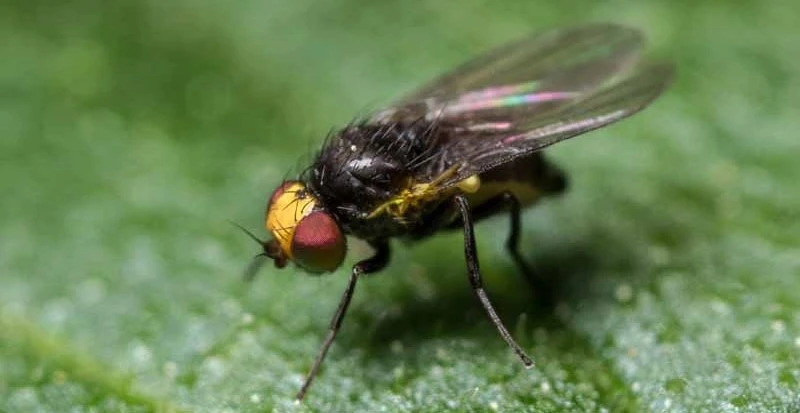
What caused it?
Symptoms are caused by several flies belonging to the family of the Agromyzidae, with several thousand species worldwide. In spring, females puncture leaf tissues and lay their eggs, usually along the margins. The larvae feed between the upper and the lower leaf surface. They produce large white meandering tunnels with a trail of black frass left behind as they feed. Once they have reached maturity, larvae open a hole on the underside of the leaf and fall to the ground, where they pupate. Plant debris near the host are alternative pupating places. Leaf miner flies are attracted to the color yellow.
Life Cycle of Leaf Miner Flies
Understanding the life cycle of leaf miner flies is crucial to controlling them. These pests have a relatively short life cycle, but they can produce multiple generations in a single growing season, especially in warmer climates.
- Egg Stage: The life cycle begins when the adult female fly lays her eggs on the surface of a leaf. Each female can lay dozens of eggs, usually inserting them into the leaf tissue using her ovipositor.
- Larval Stage: After a few days, the eggs hatch into larvae. This is the most destructive stage of the life cycle. The larvae immediately begin feeding on the mesophyll tissue inside the leaf, creating the telltale winding trails or blotches that indicate a leaf miner infestation. The larval stage lasts about a week, depending on temperature and other environmental factors.
- Pupal Stage: Once the larvae have had their fill, they exit the leaf and drop to the soil, where they pupate. The pupal stage is a period of transformation, lasting from a few days to several weeks, depending on environmental conditions.
- Adult Stage: Finally, the pupae emerge as adult flies, ready to mate and begin the cycle anew. Adults live for a few weeks, during which time they will mate and lay eggs, starting the cycle all over again.
Plants Commonly Affected by Leaf Miners
Leaf miners are not particularly picky when it comes to their food sources. They can infest a wide variety of plants, but some are more susceptible than others. Here are a few plants that are commonly targeted by leaf miner flies:
- Vegetables: Leaf miners love to attack vegetable crops, especially spinach, tomatoes, lettuce, and peas. The damage they cause can reduce yield and make the vegetables unmarketable.
- Ornamental Plants: Many ornamental plants, including columbine, chrysanthemums, and impatiens, are also frequent victims of leaf miners. The unsightly trails can ruin the appearance of these plants.
- Fruit Trees: Citrus trees are particularly vulnerable to leaf miners, which can affect both the leaves and the fruit, leading to reduced fruit quality and yield.
- Herbs: Leaf miners are also known to infest herbs like basil, parsley, and mint, making them a common problem for herb gardeners.
Apple, Bean, Bitter Gourd, Cabbage, Cauliflower, Chickpea & Gram, Coffee, Cotton, Cucumber, Brinjal, Black & Green Gram, Grape, Guava, Mango, Melon, Okra, Onion, Ornamental, Papaya, Pea, Peanut, Capsicum & Chilli, Pigeon Pea & Red Gram, Potato, Pumpkin, Soybean, Tomato, Zucchini.
Understanding which plants are most at risk can help you focus your monitoring and control efforts more effectively.
Symptoms of Leaf Miner
The first step in controlling leaf miners is recognizing the signs of their presence. Leaf miner damage is distinctive, making it relatively easy to identify once you know what to look for.
- The most common sign of leaf miner activity is the presence of winding, serpentine trails on the leaves. These trails are created by the larvae as they tunnel through the leaf tissue, feeding as they go. The trails often appear as white or yellowish lines that meander across the leaf surface.
- These burrows are usually limited by the leaf veins and contain black fecal material visible as slim trace inside the tunnels.
- Entire leaves may be covered with mines.
- In some cases, leaf miners create blotchy areas on the leaves rather than trails. These blotches occur when multiple larvae feed in close proximity, causing large sections of the leaf to die and turn brown.
- As the larvae feed, they can cause the affected leaves to curl or distort. This is especially common in citrus trees, where the damage can lead to significant leaf deformation.
- Damaged leaves may drop prematurely (defoliation). Defoliation can reduce yield and fruit size and expose fruit to sunburn. Should not be confused with Tuta absoluta (Tomato Leafminer) whose mines on leaves are wider and white or transparent.
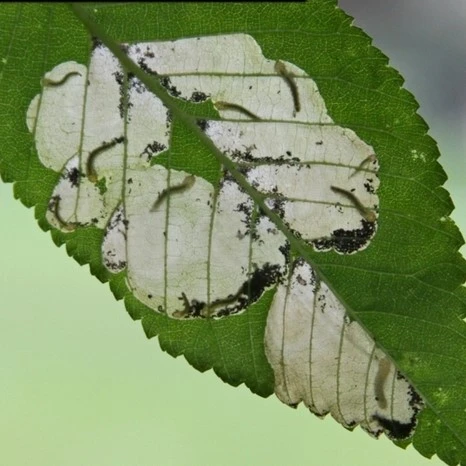
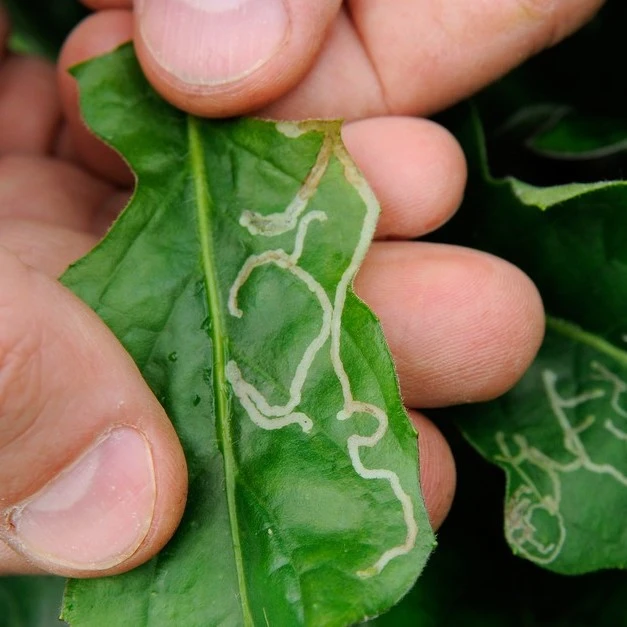
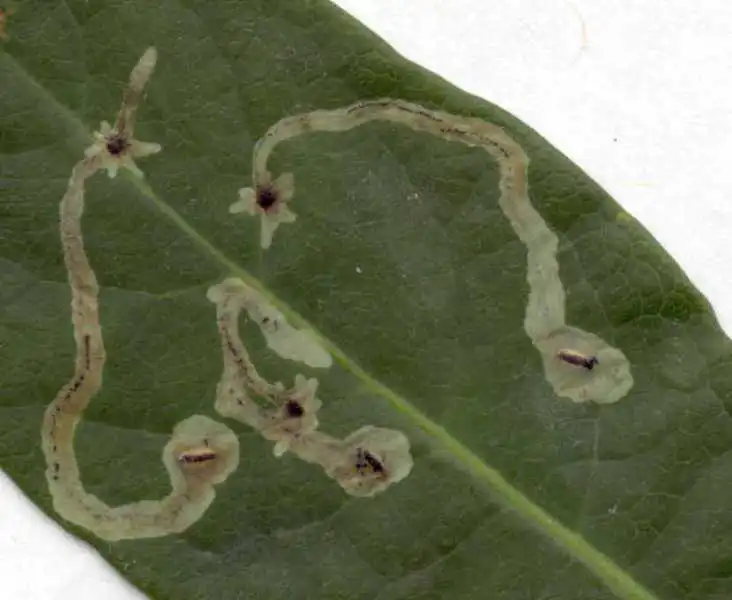
Monitoring and Early Detection Techniques
Early detection is key to managing leaf miner infestations effectively. The sooner you spot the problem, the easier it is to control. Here are some techniques to help you monitor for leaf miners:
1. Regular Plant Inspections: Make it a habit to regularly inspect your plants for signs of leaf miner activity. Pay particular attention to the undersides of leaves, where the larvae often begin their feeding.
2. Sticky Traps: Yellow sticky traps are an effective way to monitor for adult leaf miner flies. These traps attract the flies and can give you an early warning of an impending infestation.
3. Visual Inspection: If you suspect leaf miners are present, closely examine the leaves for the telltale trails or blotches. You can also hold a leaf up to the light to see the larvae inside.
4. Look for Eggs: Adult leaf miners lay their eggs on the surface of leaves. The eggs are tiny and difficult to see, but with a magnifying glass, you may be able to spot them.
Confirming Leaf Miner Presence
While the signs of leaf miner activity are usually clear, it’s important to confirm that leaf miners are indeed the cause of the damage before taking action. Here’s how to be sure:
1. Identify the Larvae: Carefully cut open an affected leaf along the trail or blotch to reveal the larvae inside. Leaf miner larvae are tiny, legless worms, usually white or yellow in color.
2. Check for Exit Holes: If you find larvae but also notice small holes in the leaves, this could indicate that the larvae have already exited the leaf to pupate.
3. Rule Out Other Pests: Some other pests, such as certain types of beetles or caterpillars, can cause similar damage. However, leaf miner damage is usually more linear and less random than that caused by other pests.
Once you’ve confirmed the presence of leaf miners, it’s time to move on to control measures.
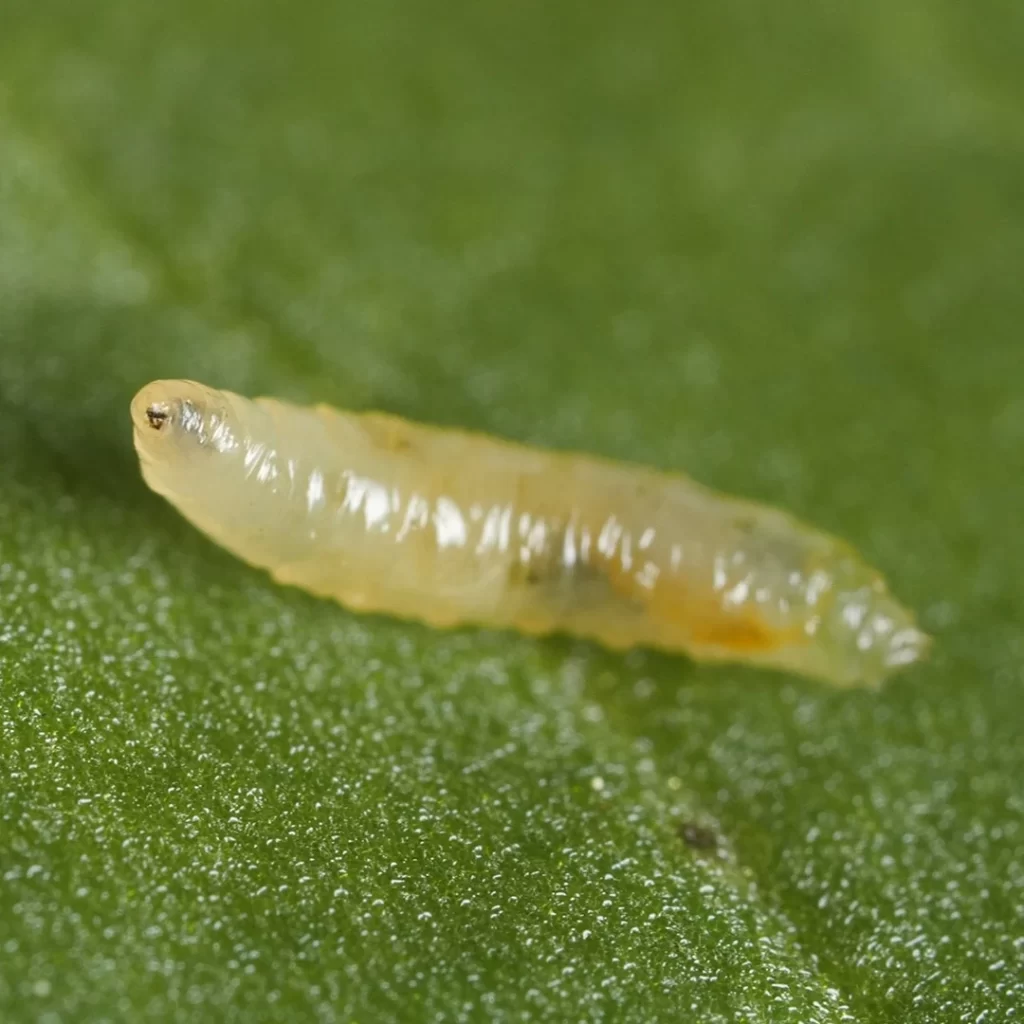


Methods for Controlling Leaf Miner Flies
Cultural Control Methods
Cultural control methods are among the most effective and environmentally friendly ways to manage leaf miner infestations. These practices focus on creating conditions that are unfavorable for the pests while promoting plant health.
1. Crop Rotation: Rotating crops is a simple yet effective way to reduce leaf miner populations. Since leaf miners often specialize in specific types of plants, rotating your crops each season can disrupt their life cycle and reduce the chances of a repeat infestation.
2. Use of Row Covers: Row covers can physically block adult leaf miners from laying their eggs on your plants. These covers are particularly useful during the early stages of plant growth when the leaves are most vulnerable.
3. Remove Affected Leaves: If you notice leaf miner activity early, one of the simplest control methods is to remove and destroy the affected leaves. This can help reduce the population of larvae before they have a chance to pupate.
4. Proper Spacing and Pruning: Ensuring that your plants are properly spaced and pruned can reduce humidity around the plants, making the environment less favorable for leaf miners. Pruning also allows for better air circulation, which can help deter adult flies from laying eggs.
Biological Control Methods
Biological control involves using natural predators or parasites to manage pest populations. This approach is sustainable and safe for the environment, making it an excellent option for organic gardeners.
1. Parasitic Wasps: One of the most effective biological controls for leaf miners is the use of parasitic wasps, such as Diglyphus isaea. These tiny wasps lay their eggs inside the leaf miner larvae, which are then consumed by the developing wasp larvae. This not only kills the leaf miners but also helps reduce their population over time.
2. Beneficial Insects: Encouraging a diverse population of beneficial insects in your garden can also help keep leaf miner populations in check. Ladybugs, lacewings, and predatory beetles all feed on leaf miner eggs and larvae, reducing their numbers naturally.
3. Neem Oil: Spray neem oil products (Azadirachtin) against larvae onto leaves in the early morning or late evening. For example, spray Neem oil (15000 ppm) at a rate of 5 ml/l. Make sure to have good leaf coverage. Neem slightly enters the leaves and reaches some of the larvae inside the tunnel.
Foliar applications of the entomophagous nematode, Steinernema carpocapsae, can reduce the leaf miner population. Other biological controls of leaf miners include parasitoids (e.g. Chrysonotomyia punctiventris and Ganaspidium hunteri) and nematodes (e.g. Steinernema carpocapsae).
Chemical Control Options
Chemical control should generally be considered a last resort, particularly in home gardens where the use of pesticides can disrupt beneficial insect populations and lead to resistance. However, in severe infestations, chemical controls may be necessary.
Always consider an integrated approach with preventive measures together with biological treatments if available. Broad-spectrum insecticides of the organophosphates, carbamates and pyrethroids families prevent adults from laying eggs, but they do not kill the larvae. Moreover, they can lead to the decrease of natural enemies and the development of resistance in the fly, which in some cases can actually result in an increase in their numbers. Products such as abamectin, chlorantraniliprole, acetamiprid, spinetoram or spinosad can be used in a rotation to avoid the development of resistance.
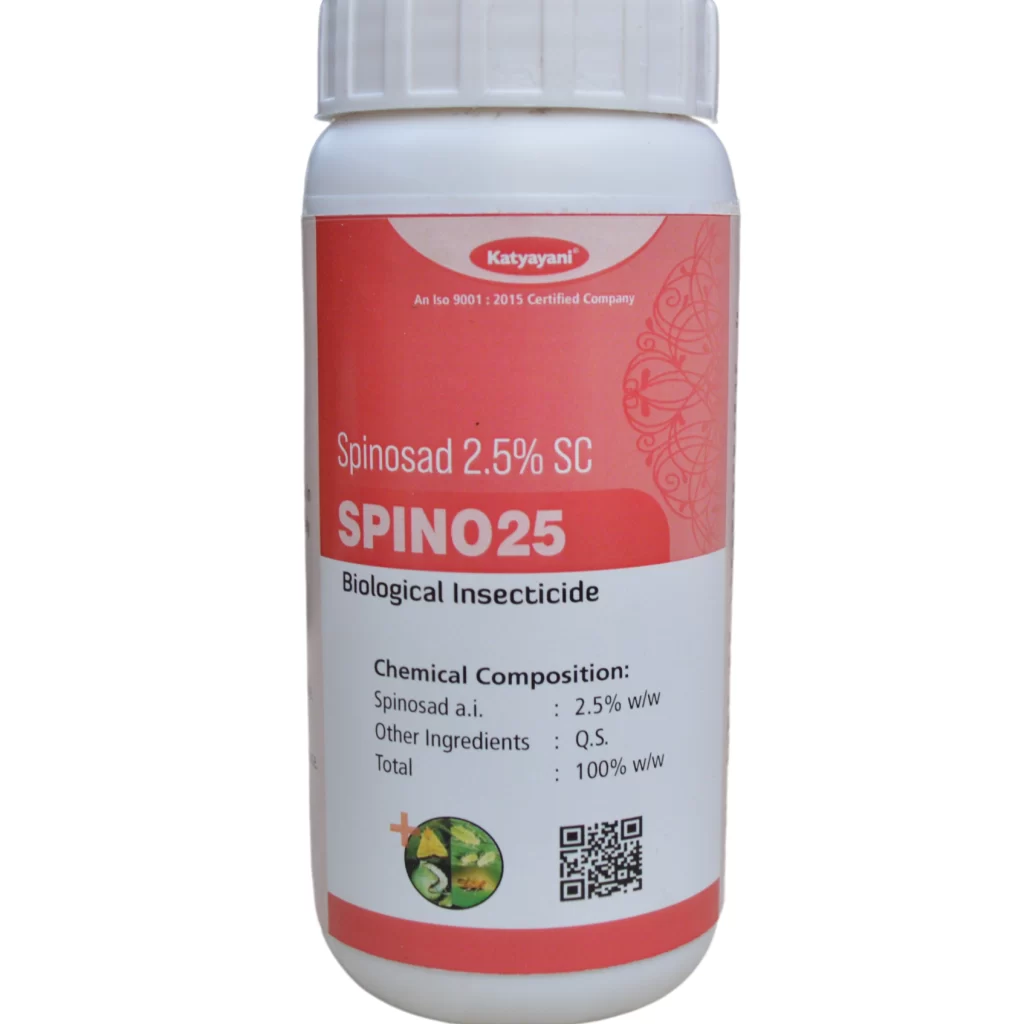

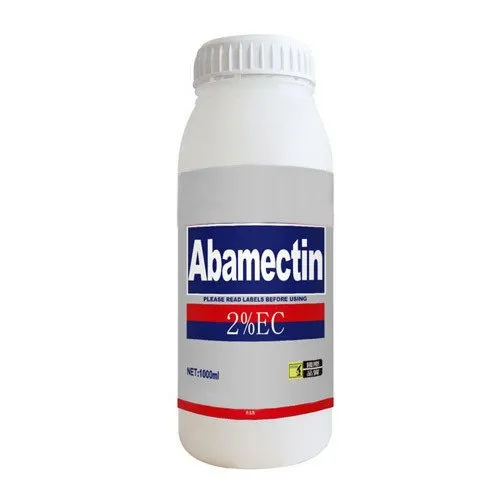

Integrated Pest Management (IPM) Approach
Integrated Pest Management (IPM) is a holistic approach that combines multiple strategies to manage pests in an environmentally and economically sustainable way. IPM focuses on long-term prevention and control, rather than just reacting to infestations.
1. Monitoring and Identification: Regular monitoring and accurate identification of leaf miners are the first steps in an IPM approach. This allows for early intervention and reduces the need for chemical controls.
2. Combining Control Methods: IPM encourages the use of a combination of cultural, biological, and, if necessary, chemical control methods. For example, you might use row covers to prevent adult flies from laying eggs, introduce parasitic wasps to control larvae, and remove infested leaves to reduce the population.
3. Record-Keeping and Evaluation: Keeping detailed records of pest activity, control methods used, and their effectiveness is an important part of IPM. This allows you to evaluate what works best in your specific situation and make adjustments as needed.
Preventive Measures to Avoid Future Infestations
Preventing leaf miner infestations before they start is the best strategy for long-term control. By following these preventive measures, you can reduce the likelihood of leaf miners becoming a problem in your garden.
- Favor crop varieties with curled leaves.
- Check transplants for leaf miners or mines before planting.
- Destroy any transplants that are infested.
- Some plants can help deter leaf miners when planted alongside susceptible crops. For example, marigolds are known to repel many pests, including leaf miners. Planting marigolds around your vegetable garden can create a natural barrier against these pests.
- Healthy plants are better able to withstand and recover from pest damage. Regularly monitor your plants for signs of stress, such as yellowing leaves or stunted growth, and take action to correct any issues. This might include adjusting watering schedules, adding fertilizer, or improving soil quality.
- The timing of planting can also affect your susceptibility to leaf miner infestations. For example, planting certain crops early in the season can help avoid the peak activity period of leaf miners. Additionally, overwintering plants indoors or using protective coverings can prevent leaf miners from establishing themselves during the colder months.
- Look for tiny tunnels and larvae inside the tunnels on the upper leaf sides.
- Use glue traps or yellow sticky traps to detect leaf miners.
- At 8 to 12 infected plants per 100 plants, consider direct control action.
- Handpick heavily-infested leaves, and destroy them by crushing or burying them, or feeding them to cattle if palatable.
- Destroy and bury the remains of weeds and dying crops.
- Remove crop debris immediately afert harvest is finished, especially for tomato crop.
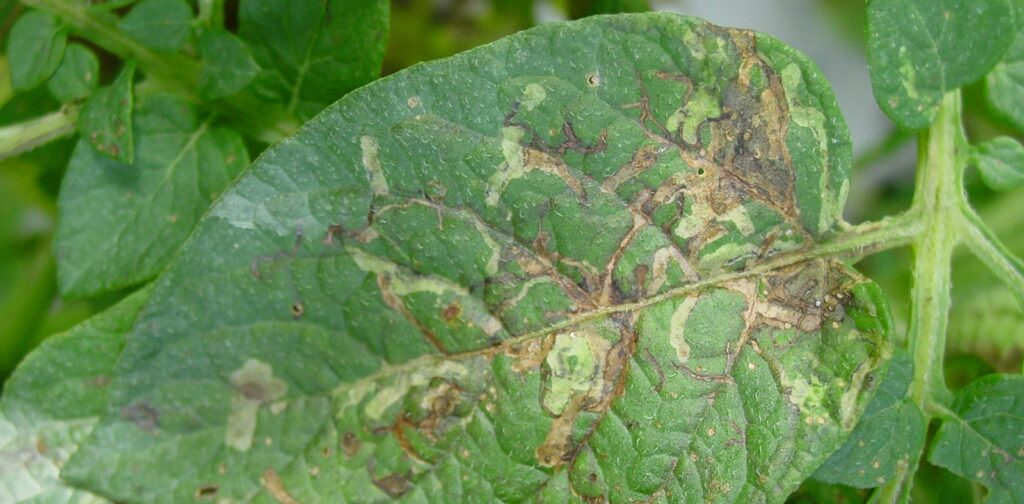
Conclusion
Leaf miner flies may be small, but their impact on your garden can be significant. These tiny pests can quickly turn your lush, green leaves into a canvas of destruction, leaving behind unsightly trails and causing serious damage to your plants. However, with the right knowledge and strategies, you can effectively identify, control, and prevent leaf miner infestations.
By understanding the life cycle and behavior of leaf miner flies, regularly monitoring your plants, and implementing a combination of cultural, biological, and chemical controls, you can protect your garden from these pesky invaders. Remember, early intervention is key, and using an Integrated Pest Management approach will help you achieve long-term success.
So, the next time you spot those telltale trails on your plants, don’t panic—arm yourself with the strategies outlined in this guide, and you’ll be well on your way to outsmarting leaf miner flies and keeping your garden healthy and thriving. Happy gardening!
